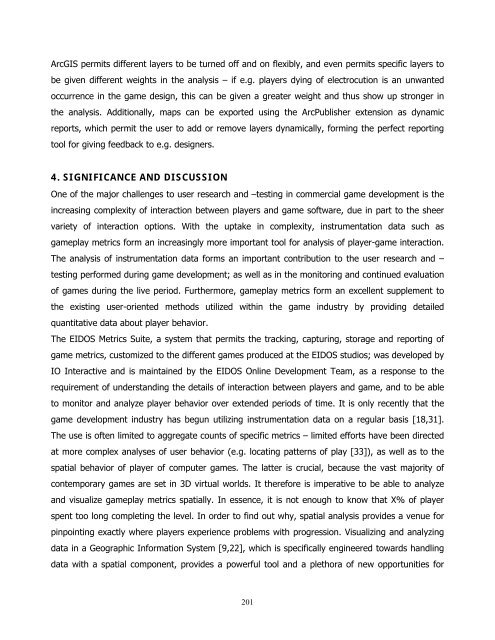Play-Persona: Modeling Player Behaviour in Computer Games
Play-Persona: Modeling Player Behaviour in Computer Games
Play-Persona: Modeling Player Behaviour in Computer Games
You also want an ePaper? Increase the reach of your titles
YUMPU automatically turns print PDFs into web optimized ePapers that Google loves.
ArcGIS permits different layers to be turned off and on flexibly, and even permits specific layers to<br />
be given different weights <strong>in</strong> the analysis – if e.g. players dy<strong>in</strong>g of electrocution is an unwanted<br />
occurrence <strong>in</strong> the game design, this can be given a greater weight and thus show up stronger <strong>in</strong><br />
the analysis. Additionally, maps can be exported us<strong>in</strong>g the ArcPublisher extension as dynamic<br />
reports, which permit the user to add or remove layers dynamically, form<strong>in</strong>g the perfect report<strong>in</strong>g<br />
tool for giv<strong>in</strong>g feedback to e.g. designers.<br />
4. SIGNIFICANCE AND DISCUSSION<br />
One of the major challenges to user research and –test<strong>in</strong>g <strong>in</strong> commercial game development is the<br />
<strong>in</strong>creas<strong>in</strong>g complexity of <strong>in</strong>teraction between players and game software, due <strong>in</strong> part to the sheer<br />
variety of <strong>in</strong>teraction options. With the uptake <strong>in</strong> complexity, <strong>in</strong>strumentation data such as<br />
gameplay metrics form an <strong>in</strong>creas<strong>in</strong>gly more important tool for analysis of player-game <strong>in</strong>teraction.<br />
The analysis of <strong>in</strong>strumentation data forms an important contribution to the user research and –<br />
test<strong>in</strong>g performed dur<strong>in</strong>g game development; as well as <strong>in</strong> the monitor<strong>in</strong>g and cont<strong>in</strong>ued evaluation<br />
of games dur<strong>in</strong>g the live period. Furthermore, gameplay metrics form an excellent supplement to<br />
the exist<strong>in</strong>g user-oriented methods utilized with<strong>in</strong> the game <strong>in</strong>dustry by provid<strong>in</strong>g detailed<br />
quantitative data about player behavior.<br />
The EIDOS Metrics Suite, a system that permits the track<strong>in</strong>g, captur<strong>in</strong>g, storage and report<strong>in</strong>g of<br />
game metrics, customized to the different games produced at the EIDOS studios; was developed by<br />
IO Interactive and is ma<strong>in</strong>ta<strong>in</strong>ed by the EIDOS Onl<strong>in</strong>e Development Team, as a response to the<br />
requirement of understand<strong>in</strong>g the details of <strong>in</strong>teraction between players and game, and to be able<br />
to monitor and analyze player behavior over extended periods of time. It is only recently that the<br />
game development <strong>in</strong>dustry has begun utiliz<strong>in</strong>g <strong>in</strong>strumentation data on a regular basis [18,31].<br />
The use is often limited to aggregate counts of specific metrics – limited efforts have been directed<br />
at more complex analyses of user behavior (e.g. locat<strong>in</strong>g patterns of play [33]), as well as to the<br />
spatial behavior of player of computer games. The latter is crucial, because the vast majority of<br />
contemporary games are set <strong>in</strong> 3D virtual worlds. It therefore is imperative to be able to analyze<br />
and visualize gameplay metrics spatially. In essence, it is not enough to know that X% of player<br />
spent too long complet<strong>in</strong>g the level. In order to f<strong>in</strong>d out why, spatial analysis provides a venue for<br />
p<strong>in</strong>po<strong>in</strong>t<strong>in</strong>g exactly where players experience problems with progression. Visualiz<strong>in</strong>g and analyz<strong>in</strong>g<br />
data <strong>in</strong> a Geographic Information System [9,22], which is specifically eng<strong>in</strong>eered towards handl<strong>in</strong>g<br />
data with a spatial component, provides a powerful tool and a plethora of new opportunities for<br />
201















